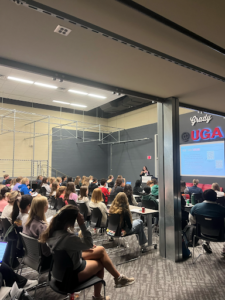 ADPR Connection Prep: Personal Branding Meeting Recap
ADPR Connection Prep: Personal Branding Meeting Recap
by Riley Mason

Samantha Meyer presenting on ADPR Connection preparations
ADPR Connection is a student-run networking event that helps students build relationships with employers. Through keynote speakers, lunch socials and a career fair, students can network with companies they are interested in. But how do you prepare for these events, and what are the ways you should be telling your story?
On October 15, PRSSA hosted an ADPR Connection prep meeting. Samantha Meyer, the director of experiential programs in Grady, along with Scott Cuppari, a professor in the Department of Marketing, gave helpful presentations to prepare for the events.
Samantha Meyer, Director of Experiential Programs
Preparing for the Event:
Preparing for the event should take some time. You should be intentional with your goals, specifically tangible hiring goals. Make sure you know if you are interested in a spring internship, summer internship or a full-time job.
What to Wear:
When selecting what to wear, go for business casual or business professional. Color and personality in your outfit are acceptable for this career fair and these employers. Aim to feel confident and comfortable in how you are presenting; it is part of your personal branding. A resource to utilize is the SGA professional closet!
Do Research:
Know who is attending and strategize before the event. Make a top 3-5 list of organizations you want to speak with and take notes on their companies. For example, check their websites for any current job or internship openings, their LinkedIn and any job descriptions on their website. You can also follow them on social media and figure out if any of your peers have been involved with any of the organizations.
Conversation Styles:
An elevator pitch, conversational networking or a combination of both may be used at the ADPR Connection events. The elevator pitch could be used at the career fair tables, and conversational networking could be used at the senior networking hour or networking luncheon. Your goal is to leave each conversation sharing about your experience and immediate goal.
Conversation Tips:
- Don’t ask about anything you can find on their websites.
- If you see a company that you don’t know yet, step outside of the room for quick research on your phone.
- Don’t interrupt a conversation.
- Stay engaged during your wait in line—observe how they’re interacting with your peers and review notes.
- If attending the event with a friend will make you nervous or self-conscious, split up.
Follow Up:
Be sure to write down people’s names and get contact information. Make notes about the conversation as soon as you leave the table; this will help you later. Write down any instructions the person you were talking to gave you, and follow them on social media or LinkedIn. Follow up within 24-48 hours via email.
Scott Cuppari, Marketing Professor
Scott Cuppari has 30 years of experience in the industry. He has worked on the Grady side and the Terry side of the house. He gives a different perspective based on his industry experience.
The STAR Method:
The STAR method is how to tell an effective story to build a better resume, get more callbacks, or secure a job interview.
- S—Situation: the context of your accomplishment. What was the problem you tried to solve?
- T—Task: what were your responsibilities?
- A—Action: what exactly did you do?
- R—Result: what was the outcome?
Create a journal of your STARs by starting with a quick list of accomplishments. These accomplishments should fall into three categories: professional experience, academic experience and other experience.
By using the STAR method, you can transform your resume bullet points into a story about yourself and your projects. Match the STARS to the job description by using as many keywords as possible. Make sure to include results in your resume, either qualitative or quantitative.
For an interview, review your journal of STARs. Take a note card of STARs that apply to the job description to review before the interview. Most importantly, let your STARs shine during the interview.